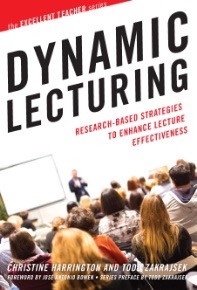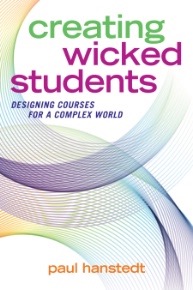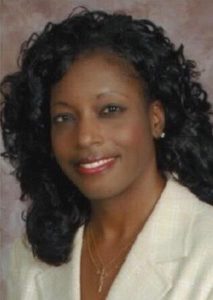student learning
Select an item by clicking its checkbox

Dynamic Lecturing: Research-Based Strategies to Enhance Lecture Effectiveness
Date Reviewed: July 18, 2018
Against the prevailing tide in higher education, Christine Harrington and Todd Zakrajsek argue that lectures, when prepared well and incorporated appropriately, are one of the most effective ways to enhance learning. The first part of their book is focused on making this case and on delineating the different forms a lecture can take. The second part of the book focuses on ways to make lectures more effective for learners. That second part takes up the bulk of the book (7 of the 11 chapters). The third part provides tools and resources for preparing and evaluating lectures. These final two chapters give helpful rubrics, charts, and questionnaires that can easily be adapted for one’s own lectures or for evaluating others’ lectures. This book would be a useful addition to an individual professor’s library and, most especially, to a center for teaching and learning library.
Both authors of Dynamic Lecturing are trained in psychology and have experience in teaching and learning and faculty development centers, so the examples are often from social science or natural science classrooms. However, many of their suggestions could easily be adapted to theology and religious studies. Using research from the scholarship of teaching and learning, they argue that lectures are efficient and effective for novice learners but are less so for expert learners (by which they mean advanced undergraduates and graduate students). This book, therefore, would be most useful for faculty who frequently teach lower-division courses for undergraduates; it could still be quite useful for those wanting to make their lectures more effective, even if they work with other learner populations and use other kinds of teaching tools.
This distinction between novice and expert learners is significant in the context of theology and religious studies: in certain courses, students may enter the classroom assuming they are the experts (for example, if the course focuses on their own religious tradition, especially if the professor is not another “insider”). Harrington and Zakrajsek’s discussion of techniques like pre-testing may be a way to address this unique dynamic: if a student took a pre-test and found that they did not know as much as they thought they knew, they might find themselves more open to learning from a professor’s lecture.
As their title suggests, this is not a book about individual teaching choices, but rather is focused on research-based strategies: nearly every paragraph has multiple citations that refer the reader to studies done on teaching and learning. A bibliography accompanies each chapter, so references are easy to track down, if desired. The studies are often explained well, so the reader knows what the research suggests; there are times, however, when the conclusions seem overstated. For example, a study used to argue that lectures are more helpful than active learning sessions to novice learners is explained in a parenthetical note: 88% of students agreed or strongly agreed that a lecture helped them learn course content compared with 49% of students who agreed or strongly agreed that active learning sessions helped them learn course content (10). Self-reporting is not the same as demonstrating mastery of the content. In other places, the authors note that students are not always the best judges of their own learning (see, for example, studies on learners’ overconfidence [115]). The research cited throughout the book is not limited to self-reporting and includes very helpful data on what promotes student engagement and learning.

Creating Wicked Students: Designing Courses for a Complex World
Date Reviewed: September 6, 2018
Paul Hanstedt
Sterling, VA: Stylus Publishing, 2018 (x + 180 pages, ISBN 978-1-62036-697-4, $24.95) One might assume that a text called Creating Wicked Students would discuss types of “wicked” problems – complex social-environmental issues that cannot be solved with existing modes of inquiry and decision-making – that instructors might address through a problem-based learning approach. However, this work actually is an introduction ...
Creating Wicked Students: Designing Courses for a Complex World
Paul Hanstedt
Sterling, VA: Stylus Publishing, 2018 (x + 180 pages, ISBN 978-1-62036-697-4, $24.95)
One might assume that a text called Creating Wicked Students would discuss types of “wicked” problems – complex social-environmental issues that cannot be solved with existing modes of inquiry and decision-making – that instructors might address through a problem-based learning approach. However, this work actually is an introduction to course design most useful for beginning instructors or those redesigning their courses according to sound pedagogical principles. Situating himself against those who view higher education as solely preparing students for the workforce or transmitting content, Hanstedt emphasizes the importance of instilling a sense of authority in our students by helping them develop skills and attitudes that will empower them to make meaningful change in the world.
Hanstedt’s holistic vision of education includes attitudes and dispositions alongside skills and content mastery, and will likely resonate with instructors in religious studies and theology. Although he does not explicitly refer to our disciplines, he does offer examples, anecdotes, and insights from colleagues in a variety of fields and institutions, which is a strength of the book. He references seminal work in the scholarship of teaching and learning – including that of: George Kuh (2008, High-Impact Educational Practices, AACU); James Zull (2002, The Art of Changing the Brain, Stylus); and David Krathwohl (2002, “A revision of Bloom’s taxonomy,” Theory into Practice 41) – but does not engage with previous scholarship on wicked problems. Readers interested in learning more about pedagogical approaches to wicked problems could consult the work of the work of: Brown et al. (2010, Tackling Wicked Problems, Routledge); Carcasson (2017, “Deliberative Pedagogy as Critical Connective” in Deliberative Pedagogy, Michigan State University); or Lee (2016, “Systems Thinking,” in Resilience by Design, Springer).
This book could be useful as an introduction to course design for someone less familiar with the fundamentals, such as how to develop measurable learning outcomes, align course goals with institutional goals, nest content within higher-order goals, engage students’ prior knowledge, or incorporate applied learning. The structure of the book allows for one to follow it step-by-step as a course design manual, and it also includes recursive “intermissions” to encourage reflection along the way. In addition, his discussion of how to prompt critical thinking through multiple-choice exams offers helpful strategies for encouraging students to explain their thinking on ambiguous questions with follow-up questions that explain or justify their choice (92-98).
Classroom discussions are never to be used as therapy – by student or by teacher. While I believe teaching and learning has the capacity to summon the elements of healing, I do not subscribe to asking teacher or learner to participate in classroom sessions structured for therapy in any respect. The ...
Is there a pedagogical responsibility to traumatize our students? I’m not thinking of some unbridled notion of “tough love” in grading, or an exaggerated insistence that actions have consequences, or even routine attempts to challenge assumptions and perspectives. Rather, is there a pedagogical responsibility to make students feel less ...
Teaching-learning is often a perilous process. Occasionally, in the midst of delivering carefully structured lectures, facilitating balanced yet critically engaging discussions, or working with students one-on-one, life intervenes in a dramatic and direct fashion. Three years ago, I was teaching a summer course on Methodist church history for Master of ...


